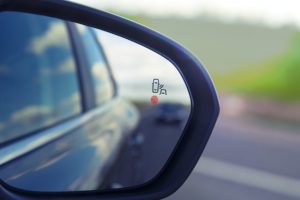How Can Blind Spots Hide Deadly Hazards?
Auto AccidentsNo matter how many side and rearview mirrors they have, virtually all vehicles have blind spots. These are places where drivers cannot see other vehicles next to them. If drivers don’t check their blind spots before merging into traffic or changing lanes, they can cause serious car accidents that result in severe, even life-threatening injuries to others.
Blind spots are a particular concern for new drivers, as they often lack the experience to look over their shoulders and make sure their path is clear. However, even experienced drivers can forget to check their blind spot and collide with a vehicle in an adjacent lane.
It’s important to understand what blind spots are and the dangers bling spots pose to other motorists. You also need to know where to turn for help if a driver’s negligence led to a blind spot accident that injured you or killed a close family member. Reach out to an experienced South Carolina car accident attorney right away to discuss your options for obtaining compensation.
WHAT ARE BLIND SPOTS IN CARS?
A blind spot is any area around your vehicle that you cannot see while looking straight ahead or using your mirrors, and you must turn your head to check beside you for other vehicles–a process known as a shoulder check. You must never rely on your peripheral vision alone to determine if another vehicle is beside you on the road.
Blind spots arise from two factors. First, rear-view and side-view mirrors reflect a limited field of view defined by their size, shape, and curvature. Anything outside that field of view is, in effect, invisible to the driver looking in the mirror. Second, a vehicle’s components (the vehicle’s frame, roof, hood, trunk, or trailer) and contents (passengers, seats, and cargo) can block a driver’s view, blinding the driver to whatever is behind those components or contents.
Generally speaking, most cars and trucks have blind spots in the following locations:
- Directly in front of the front bumper
- Directly behind the back bumper
- Behind the posts between the windshield and side windows
- On the driver’s side in a roughly triangle-shaped space extending from the driver’s shoulder backward along at least the length of the vehicle to a width of about one vehicle lane
- On the passenger’s side in a roughly triangle-shaped space extending from the front bumper backward along at least the length of the vehicle to a width of at least one vehicle lane (and sometimes two lanes)
The dimensions of a vehicle’s blind spots depend on:
- The size, shape, height, and contents (including passengers) of the vehicle;
- Weather and other road-environmental conditions; and
- The height, visual acuity, and level of alertness of the vehicle’s driver.
In other words, every vehicle has blind spots, but the location, depth, and breadth can vary widely. As detailed in this informative article from Consumer Reports, even identical vehicles can have different blind spots because of differences between the vehicles’ drivers.
How Blind Spots Put You in Danger

Blind spots endanger drivers and passengers in numerous ways.
YOU CAN’T SEE WHAT’S AROUND YOU, AND OTHER DRIVERS CAN’T SEE YOU
Blind spots put you and your passengers in danger by blinding you to vehicles, pedestrians, cyclists, and other road hazards hiding in them. They also make your vehicle potentially invisible to other drivers. Drivers who do not see hazards in their blind spots could make errant driving decisions or unsafe lane changes that cause a collision.
Common blind spot accident scenarios include:
- Sideswipe collisions between vehicles when a driver changes lanes or merges without seeing a vehicle in his blind spot
- T-bone collisions when a car or truck turns into the path of a faster-moving vehicle trying to pass in its blind spot
- Underride accidents when semi-trucks change lanes next to smaller vehicles and, in effect, trap the smaller vehicle under their trailers
- Motor vehicle collisions with pedestrians crossing the street if a driver’s windshield post creates a blind spot
- Motor vehicles backing up and running over adults, children, animals, or objects hiding in their rear blind spots
You Have to Guess Their Size and Shape
Drivers also have to guess at the size and shape of the blind spots of other vehicles to gauge what constitutes a safe distance or location when driving near them. If drivers guess wrong, then they may inadvertently put themselves and others in danger of blind spot accidents.
One common example of the hazards involved in uncertainty about the size and shape of a blind spot involves sharing the road with a station wagon or SUV stuffed full of boxes or luggage. Common scenarios include families going on vacation or college students moving in and out of their dorms. From afar, you might expect the driver of that vehicle to see you as you approach to pass, only to realize (hopefully, not too late) that the contents of the vehicle completely block the driver’s sightlines, making you invisible.
A similar driving conundrum arises when sharing the road with large trucks carrying cargo or pulling a trailer. Big rigs typically have large blind spot areas, and if truck drivers don’t shoulder-check their blind spots before merging, they could cause a catastrophic blind spot accident.
Because the physical characteristics and perceptive abilities of drivers themselves can affect the size and shape of a blind spot, you can never have 100 percent certainty that another driver sees you. That other driver’s poor vision, fatigue, or small stature could make your vehicle invisible.
TO CHECK YOUR BLIND SPOTS, YOU HAVE TO TAKE YOUR EYES OFF THE ROAD
Another danger caused by blind spots arises from the fact that, as a driver, you cannot check for hazards without turning your head and taking your eyes off the road. In other words, blind spot management more-or-less forces you to engage in a form of distracted driving by turning your head or focusing on your mirrors.
Driver distraction includes the visual distraction that occurs whenever you take your eyes off the road ahead to focus on something else, and distracted driving is a major contributing factor in car accidents, particularly rear-end collisions. At highway speeds, your car can cover nearly 100 yards in a few seconds, and if you are looking away from the road while clearing your blind spots, you may have little or no time to react to a vehicle in front of you or another road hazard.
Most of the time, the trade-off of risks between making sure no one is in your blind spot versus paying attention to the road ahead works in your favor. However, that’s not always the case.
SURPRISE AND OVERCORRECTION
Drivers who check their blind spots confront yet another danger: what they will do if they spot a vehicle in their blind spot that they did not expect to see, or if they see an unexpected road hazard approaching when they return their eyes to the road ahead.
Many drivers, no matter their level of experience, struggle to remain calm and collected in those stressful moments. Instead, they react by jerking their steering wheels a little too hard or stepping on the brakes more aggressively than they should. These overcorrections can also put drivers and their passengers at risk for a potentially deadly accident by causing them to lose control or to veer out of their lanes.
EFFECTIVE BLIND SPOT MANAGEMENT
Safely confronting the dangers of blind spots requires practice, alertness, and a healthy dose of caution. A little technological assistance can’t hurt either.
PRACTICE MAKES BETTER, NOT PERFECT
As with any human endeavor, the first step toward staying safe behind the wheel while contending with blind spots consists simply of gaining experience. As mentioned, new drivers tend to struggle a lot with blind-spot safety. By spending hours on the road in a particular vehicle, however, you can hone the habit of checking your blind spot and sensing the driving scenarios in which you need to pay extra attention to the potential for blind spot risks.
Does practice make perfect? Not exactly. Scientists have reportedly debunked the popular notion that 10,000 hours of doing anything makes you an expert. Even if you get really good at sensing blind spots, the roads have a way of offering up an infinite combination of variables to challenge your skills.
For these reasons, no matter how long you’ve been driving, and no matter how comfortable you feel behind the wheel, never assume that you know exactly where your or other drivers’ blind spots are. Small variations in vehicles, drivers, and road conditions can place large demands on your blind spot management, so always pay attention.
STAY ALERT AND AWARE OF TRAFFIC AND ROAD CONDITIONS
As a driver, you must always remain alert and aware of the numerous factors that affect your safety behind the wheel. Among the most important of those factors when it comes to blind spot management are traffic and road conditions.
We tend to think of checking blind spots as a one-off exercise. It comes from the sequential way we’re taught driving safety. First, you form the decision to change lanes. Next, you engage your turn signal. Then, you check your blind spot. Finally, you switch lanes.
For the most part, that sequence is correct. However, effective blind spot management requires that you avoid getting taken by surprise when you see a vehicle in your blind spot and that you do not take other drivers by surprise by driving your vehicle in their blind zones.
You accomplish this by keeping constant tabs on other vehicles and driving conditions, such as:
- The density of traffic behind, ahead, and around you
- Stretches of the road ahead where you expect traffic conditions to change
- The presence of trucks on the road with you
- Vehicles that you could easily lose track of if you do not pay extra attention, like motorcycles or cars that blend into the background because of their color or lack of headlights.
By staying on constant alert and aware of the evolving traffic conditions around your vehicle, you minimize the risk of getting caught off guard when you check your blind spot and of surprising other drivers when you appear in their blind spots.
MAKE CAUTION YOUR DEFAULT SETTING
Consumer electronics, appliances, and even your car arrive from the factory-tuned to default settings for ordinary operation. Default settings often promote the safest, most in-control, most predictable mode of using a product.
As a driver, you, too, should have a default setting when it comes to blind spots: CAUTION. To drive safely and avoid blind spot accidents, always assume that there is another vehicle in your blind spot, and then do whatever is necessary to prove otherwise to yourself. Similarly, always assume that other drivers cannot see you or your vehicle and take the steps required to convince yourself that they do see you after all.
Driver’s-ed instructors might refer to this mindset as “defensive driving.” We tend to think of it more like skeptical driving. By assuming the presence of danger and then forcing yourself to overcome that assumption with evidence, you adopt safe driving habits that protect you from disaster.
Some of those habits might include:
- Insisting on seeing a truck driver’s face in his mirrors to ensure you do not drive in his blind spot
- Making eye contact with a pedestrian or cyclist waiting to cross the street in front of your car
- Getting out and checking behind your car before you back out of the driveway
- Never set out on a trip with obstructions in your car that block your view
TECHNOLOGY CAN HELP
Advances in anti-blind spot technology can also keep you safe on the road.
Cars and trucks increasingly come with systems that aim to alert you to blind spot dangers or to make them visible, such as:
- Radar or camera-basedwarning systems that alert you to the presence of vehicles in your blind spots
- Front and rear-facing bumper cameras that allow you to see the area immediately in front of and behind your vehicle
- A prize-winning systeminvented by a teenager to eliminate windshield post blind spots.
Technology, however, does not solve all blind spot problems. Drivers must also follow the other guidance above to keep themselves and their passengers safe.
After a Blind Spot Accident

Even the best drivers and the most sophisticated technologies cannot eliminate the risks of blind spot accidents. If you’re in such an accident because of another driver’s negligence, keep these tips in mind to protect your health, well-being, and legal rights.
- Get to a doctor immediately. Seek medical care even if you feel all right after a blind spot accident. Some deadly accident injuries do not show symptoms immediately but need treatment right away. Visiting a doctor also ensures you have a documented record that you sustained injuries and received treatment, which is vital for your blind spot accident injury claim.
- Contact a skilled car accident injury attorney. If another driver injured you in a blind spot accident, you likely have valuable legal rights to obtain compensation for your injuries and losses. Do not assume could have done something differently to avoid a crash and do not accept blame for the crash. Instead, leave it to an experienced attorney to evaluate your rights and help you determine whether you qualify to pursue compensation for your injuries.
The South Carolina car accident attorneys at the Hughey Law Firm have extensive experience handling blind spot accident claims, and we offer free consultations so you can discuss your case with us at no cost. We also work on a contingency basis so you won’t pay anything upfront for us to represent you, and we will only accept a fee if we recover compensation for you.
Nathan Hughey, an attorney and fourth-generation South Carolinian, founded Hughey Law Firm in 2007. Before that, he spent five years defending nursing homes and insurance companies. Leveraging his experience, he now advocates for those injured or wronged by such entities, securing over $290 million in verdicts and settlements.
